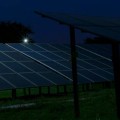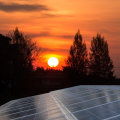Whether it's commercial or residential systems2, different types of solar energy demonstrate the range of benefits we can expect from renewable energy. The history of photovoltaic solar energy dates back to around the 1830s, when the photovoltaic effect was discovered. Later, in 1954, Bell Laboratories in the United States built the first photovoltaic solar panel. This form of solar energy is best suited to countries that see extremely high levels of sunshine.
It is therefore not surprising that Spain has the largest capacity of 2,300 MW, while the United States and South Africa follow closely with 1,738 MW and 400 MW. Solar energy for water heating started with black paint painted on tanks and used to heat water. As the black paint absorbs heat from the sun, it heats the water inside. As primitive as it may seem, it shows that we understood the power of solar energy from the beginning.
Therefore, consumer demand has seen solar pool heating increase. This works in the same way as water heating, solar energy. Photovoltaic panels or panels containing thermal conductors capture heat from sunlight and convert it into energy and, in turn, into water. Solar thermal energy, or solar thermal technology, uses heat from the sun to collect solar energy.
To heat water or produce electricity, the liquid flows through the tubes and collects energy from the sun. Compared to solar photovoltaic energy, solar thermal energy is more space efficient. Solar thermal energy can offer up to 70% more energy efficiency when it comes to collecting heat. Along with this, the technology is much less complex, which makes it ideal for heating water.
The largest solar thermal power plant is located in Morocco and has a capacity of 510MW, while the United States and Spain have several large-scale projects. Because of the way solar thermal systems work, they can reach an extremely high temperature. For example, the solar oven in Odeillo, in the French Pyrenees, can reach temperatures of up to 3,500 degrees. In most cases, solar energy has an important history that may surprise.
Today, solar energy is evolving more rapidly and is becoming more pervasive as environmental concerns and efficiency increase and. Especially since many of the technologies are more than 100 years old. Systems still have high upfront costs, but for long-term ownership, they're paying initial costs in an average of 4 to 15 years, and then pure profits. No moving parts, requires little maintenance.
Photovoltaic technology directly converts sunlight into electricity. Solar thermal technology harnesses its heat. These different technologies harness energy from the Sun, both locally and in large-scale solar farms. Photovoltaic solar panels are taking over the press, rightly so too.
They look like part of a renewable energy technology of the future. That's great, but people tend to be a little impressed by the sun and forget that photovoltaic technology is just a way to get clean energy from the sun. Electric solar panels are the rock stars of the renewable world. Thanks to the power of science and technology, these silica and glass plates convert daily sunlight into useful electricity on the go.
But like any legitimate A-list celebrity, they tend to attract a legion of detractors along with their fans and defenders. Patents for solar water heating systems date back to the 1890s in the United States. However, like photovoltaics and other renewable technologies originating in the United States, other countries have taken a considerable lead both in the development and application of our key technologies. The United States currently has about 2.3 gigawatts of thermal capacity installed.
China has 118 thermal gigawatts installed in 40 million homes. In the end, a climate-appropriate combination of the three types of solar energy, tempered with some common-sense approaches to house design, can have spectacular energy efficiency results. After all, the three methods of collecting solar energy are not only about finding an alternative to fossil fuels, but also about saving money. There are two main types of solar energy technologies: photovoltaics (PV) and concentrated solar thermal energy (CSP).
Photovoltaic solar energy provides light that is converted into electricity by photovoltaic solar panels. These photovoltaic solar panels are made up of groups of solar cells or cells that transform light (photons) into electrical energy (electrons). Solar thermal energy, also known as solar thermal energy, uses energy from the sun to produce heat, which is then used as an energy source at the domestic level (for heating the house, cooking or for personal hygiene), as well as at the industrial level, transforming this energy into mechanical energy and obtaining electrical energy. Photovoltaic solar energy and solar thermal energy use different technologies to capture and process energy from the sun.
This is known as active solar energy. However, solar energy can also be used passively, that is, without the need for any kind of mechanism to collect and use it. This is the oldest method for harnessing solar radiation. The type of solar thermal energy used to generate electricity.
It is mainly used in large-scale energy production, where flat or curved mirrors are installed in vast areas. Power plants produce electrical energy by converting energy from the sun into high-temperature heat that is channeled through a conventional generator. Concentration solar plants consist of two parts, the first one collects solar energy and converts it into heat, and the second converts thermal energy into electricity to be used to meet energy needs. Converts sunlight directly into electricity to power homes and businesses.
Solar hot water heating systems are especially effective because they are relatively cheaper to buy and install, and the underlying technology is incredibly simple: the sun overheats a glass box through which water (or other catalyst) is pumped, so it heats up in turn. The water passes through the filter and then into the solar collectors or panels that are the source of energy. The same logic applies to winter conditions, where solar penetration into the building would be ideal. Residential systems are located on rooftops in the United States, and companies are also choosing to install solar panels.
Low-temperature solar thermal technology produces heat from the sun's rays and uses it directly. These costs include permits, financing and installation of solar energy, as well as expenses incurred by solar companies to acquire new customers, pay suppliers and cover their profits. Solar technologies can harness this energy for a variety of uses, including generating electricity, providing light or a comfortable indoor environment, and heating water for domestic, commercial or industrial use. Falling panel prices, grid-connected systems and healthy tax incentives have brought this form of solar energy into the mainstream.
Usually, several solar cells form a photovoltaic panel, which produces a direct current that converters convert into alternating current. Although tax credits are expiring, this form of electricity generation is proving to be more cost-effective than coal-fired power plants, natural gas and nuclear power. Solar thermal collectors are used to absorb heat from the Sun's rays and transfer it to a heat transfer fluid, such as air, water or antifreeze, which in turn transports it to areas to be heated. .
.












Leave a Comment